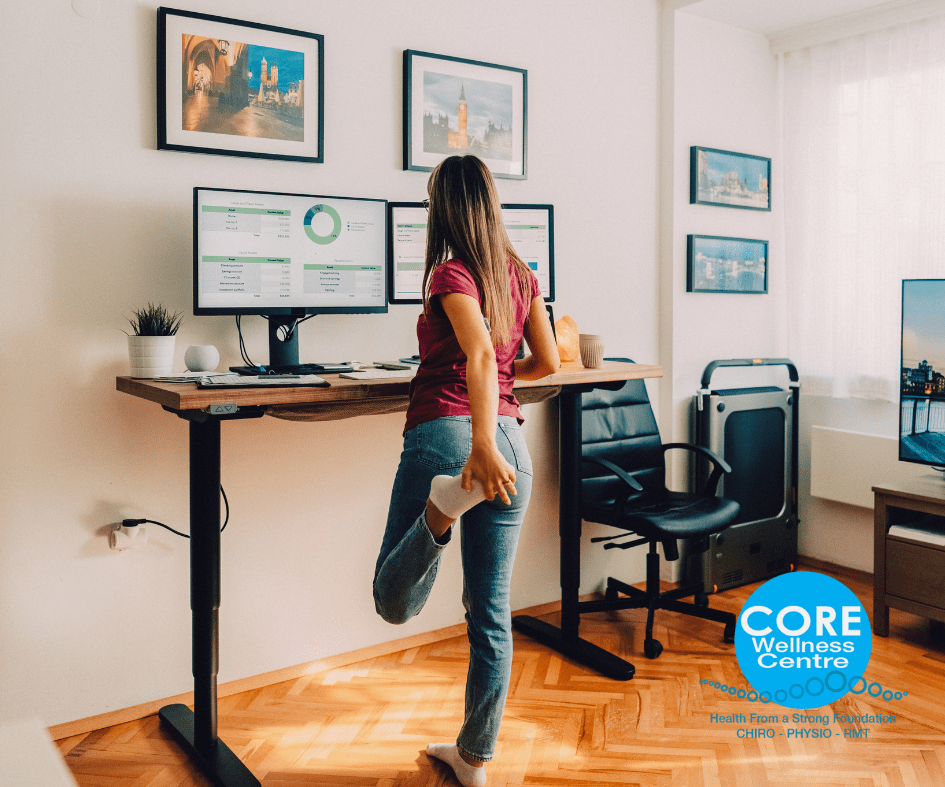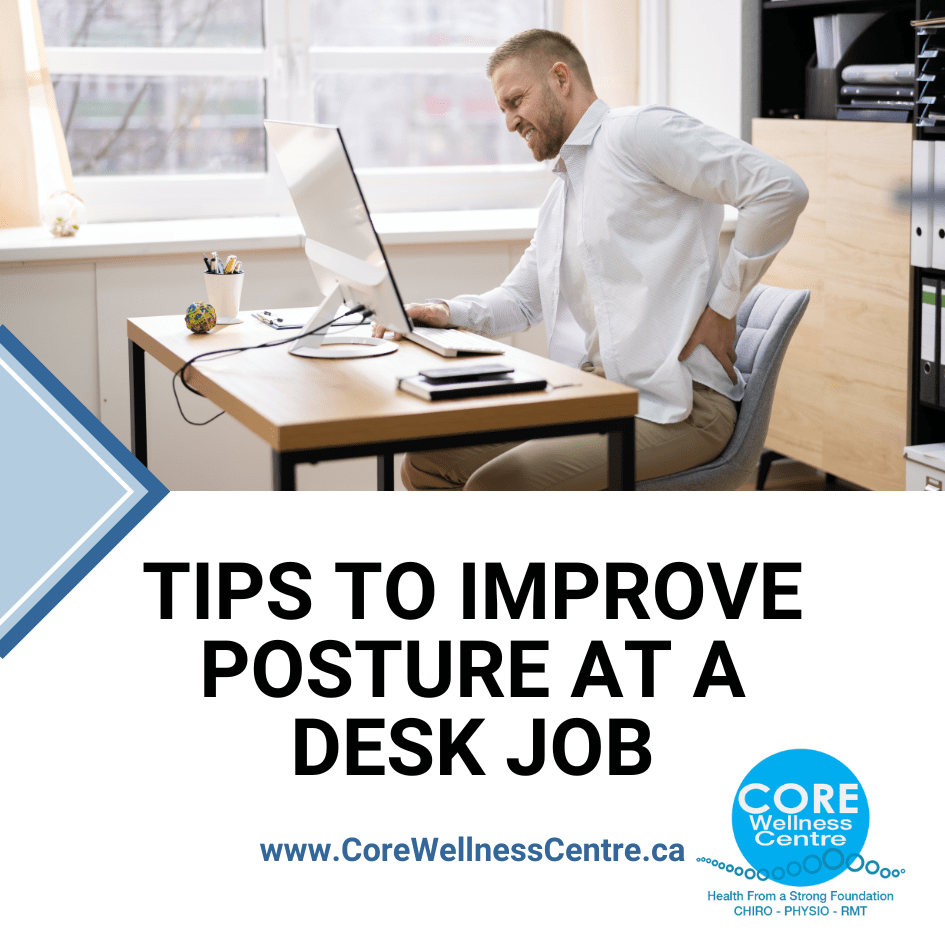
Our guide for injury prevention tips for today’s fast-paced workplace, provides desk workers in the office and remote workers strategies for long-term health and well-being.
Many desk workers spend long periods of time seated in a chair, combined with poor ergonomics and repetitive tasks, that can lead to a number of issues such as neck strain, back pain, RSI, wrist stiffness and pain and headaches.
There are proactive measures to take to prevent these injuries and Core Wellness Centre’s multi-disciplinary team of professionals offer expert guidance and advice.
Here are common injuries faced by office and at home workers and valuable insights and strategies for injury prevention.
Common Office and Desk-Related Injuries
Office environments often contribute to a range of back and neck pain among desk workers. These include the notorious trio of back pain, neck strain and carpal tunnel syndrome, all stemming from prolonged periods of sitting and repetitive movements.
Back pain, particularly in the lower back, is common due to poor posture and inadequate lumbar support in office chairs. Neck strain often accompanies prolonged screen time and incorrect monitor positioning.
In addition, carpal tunnel syndrome, that has numbness and tingling in the hands and wrists, arises from repetitive typing and mouse usage.
7 Injury Prevention Tips for Office Workers
Maintain Proper Posture
Sit with your feet flat on the floor, knees at a 90-degree angle, and spine aligned with the back of the chair
Take Regular Breaks
Stand up, stretch, and walk around for a few minutes every hour to alleviate muscle tension and improve circulation
Take Micro-Breaks for Eye Rest
Give your eyes a break from screens by following the 20-20-20 rule – every 20 minutes, look at something 20 feet away for 20 seconds
Adjust Your Workstation Ergonomics
Ensure your chair, desk, and computer setup are adjusted to support a neutral posture and reduce strain on your body
Incorporate Desk Exercises
Integrate simple stretches and exercises into your work routine to promote flexibility and prevent stiffness
Manage Stress Effectively
Practice stress-reduction techniques such as deep breathing, mindfulness, and time management to alleviate physical tension and promote overall well-being
Keep Your Workspace Organized
Cluttered workspaces can contribute to distractions and increase the risk of accidents. Keep your desk tidy and organized to create a safer and more productive work environment.

Causes of Office Related Injuries
The causes of office-related injuries are multifaceted, rooted in the sedentary nature of many jobs and exacerbated by various factors. Prolonged sitting and sedentary behavior are primary contributors, leading to muscle stiffness, decreased circulation, and increased pressure on spinal discs.
Poor workstation ergonomics further compound these issues, with improperly adjusted chairs and desks contributing to postural problems and back strain.
Repetitive movements, such as typing and mouse clicking, place undue stress on specific muscle groups and joints, leading to overuse injuries over time. Additionally, mental stress commonly experienced in office settings can manifest as physical tension and discomfort, worsening neck and back strain issues.
Understanding these underlying causes is crucial in implementing effective injury prevention strategies for office workers.
Injury Prevention Strategies for Office Employees
To safeguard against the risks associated with office work and promote long-term well-being, it’s important to adopt effective injury prevention strategies. Our team of physiotherapists recommend several key approaches to minimize the likelihood of office-related injuries.
To begin, attention should be given to establishing an ergonomic workstation setup. This involves adjusting chair and desk height to maintain a neutral posture, positioning the computer monitor at eye level to reduce strain on the neck, and integrating ergonomic accessories like lumbar supports and wrist rests for added comfort and support throughout the workday.
In addition to optimizing workstation ergonomics, incorporating regular movement breaks is vital for mitigating the effects of prolonged sitting. Employees are encouraged to take short breaks every hour to stretch and engage in light physical activity, fostering better circulation and relieving muscle tension.
Furthermore, incorporating desk exercises into daily routines can help alleviate strain and promote flexibility. By prioritizing posture awareness, employees can be educated on the importance of maintaining proper alignment and provided with practical tips for adjusting their workstation setup to support optimal posture.
Stress management techniques play a crucial role in preventing
office-related injuries. High levels of stress can exacerbate
physical tension and strain, causing an increase in back and neck issues.
Therefore, promoting stress-reduction strategies such as deep breathing exercises, mindfulness practices and time management techniques can contribute to overall well-being.
Providing resources for support and offering stress management workshops further empowers employees to cope with workplace stressors effectively.

Implementing Healthy Habits in the Workplace
Creating a workplace culture that prioritizes employee health and well-being is essential for preventing office-related injuries. Establishing a supportive office environment involves fostering a culture of wellness where employees feel valued and supported in their efforts to maintain back and neck health.
This can include providing ergonomic assessments and workstation evaluations to identify potential risk factors and address individual needs.
Implementing policies that encourage regular movement breaks and stretching sessions throughout the workday can significantly impact employee comfort and productivity. By scheduling wellness activities and ergonomic training sessions, organizations demonstrate their commitment to promoting employee health and safety.
Providing incentives for participation in workplace wellness initiatives can further motivate employees to prioritize their physical well-being.
Equally important is the provision of resources for employee education and support. Offering workshops on ergonomics, posture, and stress management equips employees with the knowledge and tools they need to maintain musculoskeletal health.
Additionally, providing access to ergonomic tools and equipment, such as adjustable chairs and standing desks, demonstrates a commitment to employee comfort and well-being. By encouraging participation in physical activity programs and wellness challenges, organizations can foster a culture of health and vitality in the workplace.
Prioritize Injury Prevention Strategies Among Office Workers
By implementing the recommended strategies outlined by our physiotherapists, organizations can significantly reduce the risk of office-related injuries and create a supportive workplace environment conducive to employee comfort and productivity.
By investing in employee education and providing resources for support, organizations demonstrate their commitment to fostering a culture of wellness where employees feel valued and empowered to prioritize their physical health.
Ultimately, injury prevention is a shared responsibility that requires collaboration between employers and employees. By working together to implement healthy habits and promote neck and back health in the workplace, we can create environments that support the well-being of all individuals.

For personalized advice and further assistance in implementing injury prevention strategies, we encourage you to reach out to Core Wellness Centre
- Chiropractic Care
- Physiotherapy
- RMT Massage Therapy
- Osteopathy
- Spinal Decompression and Y Strap
- Posture Analysis
- WSIB / Direct Billing
Why Choose Core Wellness Centre in Toronto
Experience relief and rejuvenation at our premier chiropractic, physiotherapy, RMT, and osteopathy clinic in Toronto. Whether you’re seeking relief from chronic pain, recovering from an injury, or simply aiming to enhance your overall well-being, our team of skilled healthcare professionals is here to support you on your journey to optimal health.
Schedule your appointment today to discover the transformative benefits of our personalized treatments and multi-disciplined care approach.
Take the first step towards a pain-free and revitalized life!
Your path to wellness starts here.

